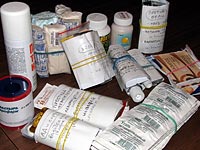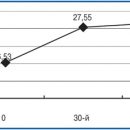Subfebrile body temperature occurs under the action of pyrogenic substances that fall into the organism of the environment. As pyrogenic substances protrude microbial toxins, the products of the exchange and decay of microorganisms.
Content
Concept of pyrogenic substances
Fever - typical thermostat protective-adaptive reaction of the body to the effect of pyrogenic substances (substances causing an increase in body temperature). Under the action of pyrogen, a temporary restructuring of the process of heat exchange for maintaining a higher than normal, heat-containing and body temperature.
The basis of fever lies a peculiar reaction of the hypothalamic centers of the brain thermoregulation at various diseases on the action of pyrogenic substances. Admission to the body of exogenous pyrogenic substances, that is, substances from the environment (for example, bacterial) pyrogenic substances causes the appearance of secondary (endogenous or internal) pyrogenic substances that differ from bacterial - thermal stability. Endogenous pyrogenic substances are formed in the body by cells of the immune system when contacting them with bacterial pyrogen substances or aseptic inflammation products.
In case of infectious fever with pyrogenins, microbial toxins are served, the products of the exchange and decay of microorganisms. Bacterial pyrogenic substances are strong stressful agents, and the introduction of them into the body causes a stressful (hormonal) reaction accompanied by an increase in the number of leukocytes - leukocytosis. This reaction developed during evolution is a non-specific symptom of many infectious diseases.
Non-infectious fever can be caused by plant, animals or industrial poisons, it is possible in allergic reactions, parenteral administration of protein, aseptic inflammation, tissue necrosis due to circulatory impairment, with tumors, neurosis, vegetative-vascular dystonia. The leukocytes penetrate the focus of inflammation or tissue damage, which produce leukocyte pyrogenicity. An increase in body temperature without the participation of pyrogen is noted in emotional stress; Some researchers consider this reaction as a similar fever. The state of mixed genesis.
Body temperature improvement mechanisms
 Increased body temperature during fever is carried out by mechanisms of physical and chemical thermostat. The increase in heat-product occurs mainly due to muscle tremors, and the limitation of heat transfer - as a result of spasm of peripheral blood vessels and reduce sweating. Normally, these thermostat reactions are developing during cooling. The inclusion of them in the fever is determined by the action of pyrogenic substances on the nerve cells of the region of the forelock of the hypothalamus.
Increased body temperature during fever is carried out by mechanisms of physical and chemical thermostat. The increase in heat-product occurs mainly due to muscle tremors, and the limitation of heat transfer - as a result of spasm of peripheral blood vessels and reduce sweating. Normally, these thermostat reactions are developing during cooling. The inclusion of them in the fever is determined by the action of pyrogenic substances on the nerve cells of the region of the forelock of the hypothalamus.
During a fever before increasing the body temperature, the thresholds of the sensitivity of the thermoregulation center to the temperature signals arriving in it. The activity of cold-sensitive nerve cells of the hypothalamus increases, and heat-sensitive - decreases.
Increased body temperature during fever differs from the overheating of the body in that it develops regardless of the fluctuations in ambient temperature, and the degree of this increase is actively regulated by the organism. In the organism overheating, the body temperature increases only after the maximum voltage of the physiological mechanisms of heat transfer is insufficient to remove heat into the environment at the speed with which its formation occurs in the body.









